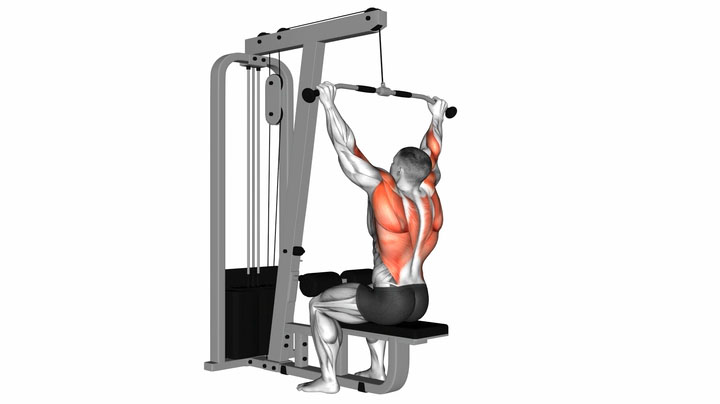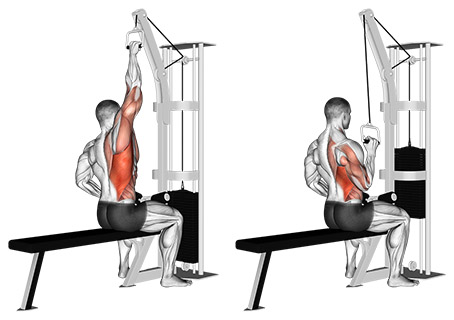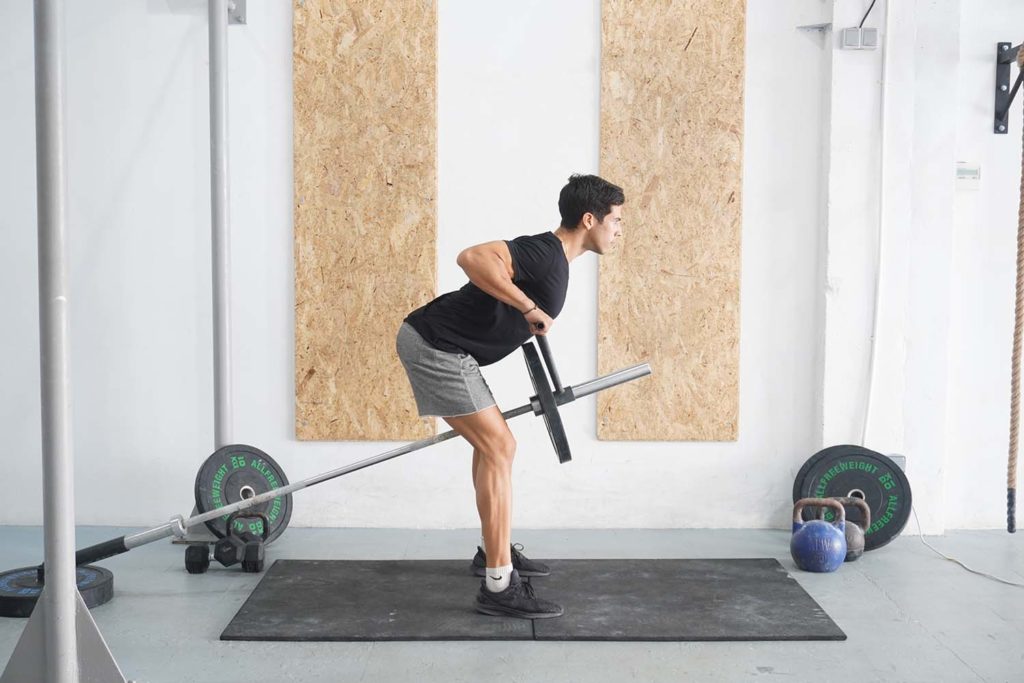The Benefits of the Lat Pulldown with a Resistance Band
The resistance band lat pulldown might not seem any different from any pulldown variation you would do on a machine. The range of motion is identical; you train the same muscles and maintain the same posture. So why bother with the banded version?
Training with a resistance band is a unique experience because of linear variable resistance (LVR). The more you stretch a resistance band, the more tension it provides. Meaning the closer you get to the end of the range of motion, the harder your muscles have to work.
Linear variable resistance is beneficial because it forces you to train with good technique, maintain muscle tension, and work extra hard near the end.
You feel little to no resistance when you first pull on the resistance band. But as it lengthens, your back and biceps have to activate more and more for you to keep going.
How to do a Band Lat Pulldown

- Attach an open-ended resistance band with handles above your head. For example, you can use a resistance band door anchor.
- Grab both handles with palms facing forward and get down on your knees to lengthen the band and create tension.
- Squeeze your glutes, engage your abs, and bring your shoulders back and down.
- Take a breath and pull the resistance band down and toward your upper chest.
- Hold the contraction for a second and release both ends of the band slowly as you exhale. Extend your arms fully but avoid protracting your shoulders near the top.
- Take another breath and pull both ends of the band.
You can also do the single-arm version if your band is light and doesn’t provide much resistance. The only difference is that you would grab both handles with one hand, do your repetitions, then switch and train your other side.
What muscles does lat pulldown (band) activate?
The primary muscle group that works during banded lat pulldowns is the latissimus dorsi (also known as ‘the lats’), the largest muscle in the upper body (1).
The lats originate from the lower back and scapula and insert into the humerus. Their origin and insertion points allow the lats to contribute to shoulder flexion and extension, scapular depression, lateral torso flexion, and more (2).
Banded lat pulldowns also involve our biceps, which produce elbow flexion. As we pull the band down, our biceps contribute by bending the arm (1).
Our rhomboids, middle and lower trapezius, rear deltoids, infraspinatus, and erector spinae also contribute during lat pulldowns, mainly to keep our shoulders back and help with stability.
Some of these muscles have an active role, but our lats are the ones that do most of the work.
Tips for Proper Form when doing a Lat Pulldown with a Resistance band
The most important thing to remember for banded lat pulldowns is to lengthen the band slowly. Doing so will allow you to keep tension on your muscles and achieve better activation for muscle growth.
It’s also essential to keep your shoulder blades back. That way, you can keep your shoulders in a better position and engage your back muscles better.
You can also make an interesting tweak to your technique if you choose to do single-arm banded lat pulldowns. Since one of the functions of our lats is lateral flexion (bending your torso to the side), you can add this element when pulling the weight down.
For example, you would start pulling the band down and add a slight side bend just as you’re in the bottom position and squeezing your lat. Doing so isn’t essential, but it might help you achieve slightly better lat activation.
Another thing to keep in mind is to keep your elbows somewhat tucked and pointing down. Flaring your elbows isn’t ideal because it places your shoulders at a mechanical advantage, forcing them to do more of the work.
Variations and Modifications of the Lat Pulldown (band)
1. Single Arm Lat Pulldown (Band)
The single arm lat pulldown is an excellent variation to train one side at a time and make good use of a lighter resistance band. Working one side is beneficial for muscle activation because you can direct your attention to fewer muscles.
2. Supinated Lat Pulldown (Band)
The supinated lat pulldown is a variation where you rotate your palms in, making them face back. Doing so allows you to engage your biceps better while also training your back.
3. Pause Lat Pulldown (Band)
The pause lat pulldown is fantastic, especially when using a resistance band. The goal is to pull the band to the bottom position and squeeze your lats for two to three seconds.
Doing the movement with a band is even better because of the progressively greater resistance. As a result, you can use the band’s peak tension during the pause and cause more significant disruption.
Mistakes to Avoid
A common mistake with the band lat pulldown is not using a full range of motion. Trainees often fail to pull the band all the way or don’t extend their arms fully at the top position. Avoid this mistake because it limits muscle activation and makes the movement much less effective.
Another mistake is not having the right resistance band for the job. For example, you might use a looped resistance band that offers little to no tension at the top but gets too tough near the bottom. Using such a band is bad because it prevents you from stretching your lats under load and limits your range of motion, often forcing you to use momentum.
The third mistake to look out for is leaning your torso too far back. Avoid this error by keeping your torso upright and only leaning back slightly. Leaning back isn’t necessarily bad for training your back, but it limits lat involvement, defeating the purpose of a ‘lat’ pulldown.
The last mistake to avoid is flaring your elbows out, which often happens when trainees lean too far back. As a result, you shift the emphasis to your shoulders, forcing them to do more of the work, while your lats contribute much less.
Similar Exercises to the Lat Pulldown (band)
Lat Pulldown (Cable)

The cable lat pulldown is similar to the banded versions. Both movements feature an identical range of motion and train the same muscles. You have to maintain the same posture in both exercises and keep many of the same training tips and mistakes in mind.
The primary difference is that a cable offers consistent tension from start to finish, where a band starts light and gets progressively more challenging.
Single Arm Lat Pulldown (Cable)

The single arm lat pulldown with a cable is another similar movement to the banded variation. The range of motion is the same, and you have to maintain the same body position. Aside from the tension difference between cables and bands, the variation also differs because you get to train one side at a time.
T Bar Row

The T bar row is a fantastic back exercise that shares some similarities to pulldowns. Most notably, you get to train your back and biceps in both movements.
The primary difference is your torso position on both activities, which determines muscle activation. T bar rows emphasize the mid and lower back better, where lat pulldowns focus on the lats.

